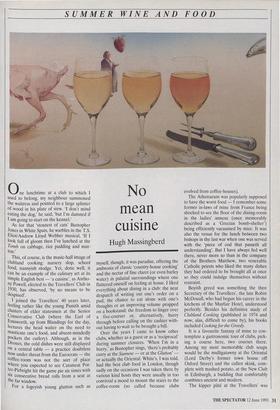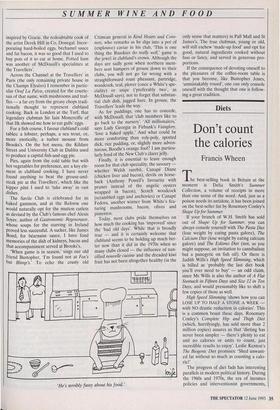SUMMER WINE AND FOOD
No mean cuisine
Hugh Massingberd
One lunchtime at a club to which I used to belong, my neighbour summoned the waitress and pointed to a large splinter of wood in his plate of stew. 'I don't mind eating the dog,' he said, 'but I'm damned if 1 am going to start on the kennel.'
As for that 'stoutest of cats' Bustopher Jones in White Spats, he warbles in the T.S. Eliot/Andrew Lloyd Webber musical, 'If I look full of gloom then I've lunched at the Tomb on cabbage, rice pudding and mut- ton.'
This, of course, is the music-hall image of Clubland cooking: nursery slop, school food, nannyish stodge. Yet, done well, it Can be an example of the culinary art at its simple English best — 'a cuisine', as Antho- ny Powell, elected to the Travellers' Club in 1930, has observed, 'by no means to be despised'.
I joined the Travellers' 40 years later, feeling rather like the young Psmith amid clusters of elder statesmen at the Senior Conservative Club (where the Earl of Emsworth, up from Blandings for the day, lectures the head waiter on the need to masticate one's food, and absent-mindedly pockets the cutlery). Although, as in the Drones, the cold dishes were still displayed on a central table — a practice doubtless now under threat from the Eurocrats — the coffee-room was not the sort of place where you expected to see Catsmeat Pot- te r-pirbright hit the game pie six times with six consecutive bread rolls from a seat at the far window.
For a fogeyish young glutton such as myself, though, it was paradise, offering the ambrosia of classic 'country-house cooking' and the nectar of fine claret (or even barley water) in palatial surroundings where one flattered oneself on feeling at home. I liked everything about dining in a club: the neat despatch of writing out one's order on a pad; the chance to eat alone with one's thoughts or an improving volume propped on a bookstand; the freedom to linger over a five-courser or, alternatively, hurry through before calling on the cashier with- out having to wait to be brought a bill.
Over the years I came to know other clubs, whether as a guest or as a 'reciprocal' during summer closures. 'When I'm in a hurry,' as Bustopher sings, 'there's probably curry at the Siamese — or at the Glutton' or actually the Oriental. White's, I was told, had the best club food in London, though sadly on the occasions I was taken there by various kind hosts they were usually in too convivial a mood to mount the stairs to the coffee-room (so called because clubs
evolved from coffee-houses).
The Athenaeum was popularly supposed to have the worst food — I remember some former in-laws of mine from France being shocked to see the floor of the dining-room in the ladies' annexe (once memorably described as a 'Grecian bomb-shelter') being efficiently vacuumed by mice. It was also the venue for the lunch between two bishops in the last war when one was served with the 'piece of cod that passeth all understanding'. But I have always fed well there, never more so than in the company of the Brothers Matthew, two venerable Catholic priests who liked the many dishes they had ordered to be brought all at once so they could indulge themselves without restraint.
Boyish greed was something the then Secretary of the Travellers', the late Robin McDouall, who had begun his career in the kitchens of the Mayfair Hotel, understood perfectly. Besides his definitive study of Clubland Cooking (published in 1974 and now, alas, difficult to come by), his books included Cooking for the Greedy.
It is a favourite fantasy of mine to con- template a gastronomic tour of clubs, pick- ing a course here, two courses there. Among my most memorable club soups would be the mulligatawny at the Oriental (Lord Derby's former town house off Oxford Street) and the cullen skink, com- plete with mashed potato, at the New Club in Edinburgh, a building that comfortably combines ancient and modern.
The kipper pâté at the Travellers' was inspired by Gracie, the redoubtable cook of the artist Derek Hill in Co. Donegal. Incor- porating hard-boiled eggs, béchamel sauce and fat bacon, it was so good that I used to buy pots of it to eat at home. Potted ham was another of McDouall's specialities at the Travellers'.
Across the Channel at the Travellers' in Paris (the only remaining private house in the Champs Elysees) I remember in partic- ular Oeuf La Palva, created for the courte- san of that name, with mushrooms and truf- fles — a far cry from the greasy chops tradi- tionally thought to represent clubland cooking. Back in London at the Turf, that legendary clubman Sir lain Moncreiffe of that Ilk showed me how to eat gulls' eggs.
For a fish course, I favour clubland's cold tables: a lobster, perhaps, a sea trout, or, more exotically, a turbot mousse from Brooks's. On the hot menu, the Kildare Street and University Club in Dublin used to produce a capital fish-and-egg pie.
Pies, again from the cold table but with hot vegetables for preference, are a key ele- ment in clubland cooking. I have never found anything to beat the grouse-and- steak pie at the Travellers', which like the kipper pâté I used to 'take away' in vast dishes.
The Savile Club is celebrated for its baked gammon, and at the Reform one would naturally opt for the mutton cutlets as devised by the Club's famous chef Alexis Soyer, author of Gastronomic Regenerator, whose soups for the starving in Ireland proved less successful. A sucker, like James Bond, for béarnaise sauce, I have fond memories of the dish of kidneys, bacon and that accompaniment served at Brooks's.
`When game is in season,' sings our old friend Bustopher, 'I'm found not at Fox's but Blimp's.' To echo the crusty old Crimean general in Kind Hearts and Coro- nets, who remarks as he digs into a pot of (explosive) caviar in his club, 'This is one thing the Russkies do really well,' game is the jewel in clubland's crown. Although the days are sadly gone when northern mem- bers sent hampers of grouse down to their clubs, you will not go far wrong with a straightforward roast pheasant, partridge, woodcock, teal, plover (once a White's spe- ciality) or snipe (`preferably two', as McDouall says), not to forget that substan- tial club dish, jugged hare. In grouse, the Travellers' leads the way.
As for puddings, one has to concede, with McDouall, that 'club members like to go back to the nursery'. 'All millionaires,' says Lady Georgia in Firbank's Vainglory, `love a baked apple.' And what could be more comforting than roly-poly, spotted dick, rice pudding, or, slightly more adven- turous, Boodle's orange fool? I am particu- larly fond of the New Club's claret jelly.
Finally, it is essential to leave enough room for that club speciality, the savoury whether Welsh rarebit, Canapé Diane (chicken liver and bacon), devils on horse- back (Anthony Powell's favourite with prunes instead of the angelic oysters wrapped in bacon), Scotch woodcock (scrambled eggs and anchovies) or Canapé Fedora, another winner from White's fea- turing mushrooms, bacon, olives and pimentos.
Today, most clubs pride themselves on how much the cooking has 'improved' since the tad old days'. While that is broadly true — and it is certainly welcome that clubland seems to be holding up much bet- ter now than it did in the 1970s when so many clubs closed — the influence of nan- cified nouvelle cuisine and the dreaded kiwi fruit has not been altogether healthy (in the `He's terribly fussy about his food.' only sense that matters) in Pall Mall and St James's. The true clubman, young or old, will still eschew `made-up food' and opt for good, natural ingredients cooked without fuss or fancy, and served in generous pro- portions.
If the consequence of devoting oneself to the pleasures of the coffee-room table is that you become, like Bustopher Jones, `unmistakably round', one can only console oneself with the thought that one is follow- ing a great tradition.



































































 Previous page
Previous page